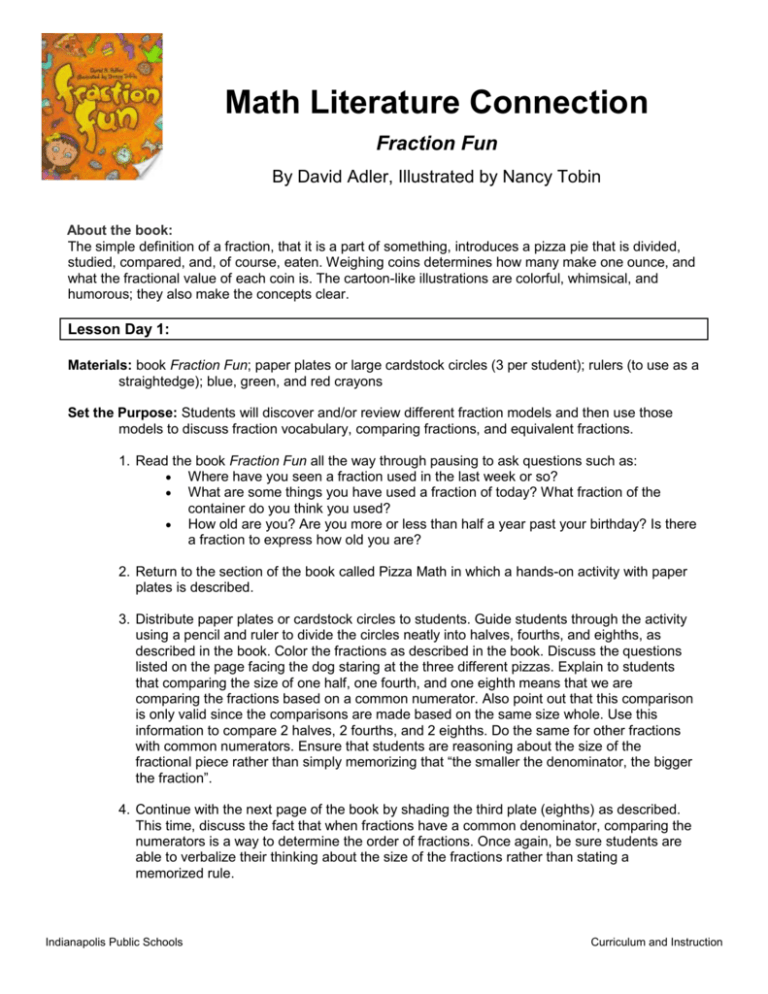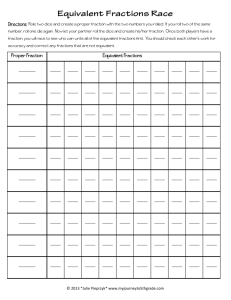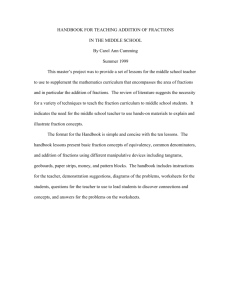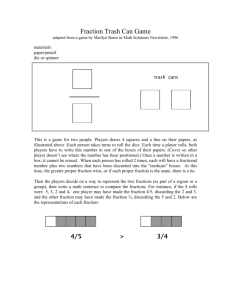Math Literature Connection Fraction Fun
advertisement

Math Literature Connection Fraction Fun By David Adler, Illustrated by Nancy Tobin About the book: The simple definition of a fraction, that it is a part of something, introduces a pizza pie that is divided, studied, compared, and, of course, eaten. Weighing coins determines how many make one ounce, and what the fractional value of each coin is. The cartoon-like illustrations are colorful, whimsical, and humorous; they also make the concepts clear. Lesson Day 1: Materials: book Fraction Fun; paper plates or large cardstock circles (3 per student); rulers (to use as a straightedge); blue, green, and red crayons Set the Purpose: Students will discover and/or review different fraction models and then use those models to discuss fraction vocabulary, comparing fractions, and equivalent fractions. 1. Read the book Fraction Fun all the way through pausing to ask questions such as: Where have you seen a fraction used in the last week or so? What are some things you have used a fraction of today? What fraction of the container do you think you used? How old are you? Are you more or less than half a year past your birthday? Is there a fraction to express how old you are? 2. Return to the section of the book called Pizza Math in which a hands-on activity with paper plates is described. 3. Distribute paper plates or cardstock circles to students. Guide students through the activity using a pencil and ruler to divide the circles neatly into halves, fourths, and eighths, as described in the book. Color the fractions as described in the book. Discuss the questions listed on the page facing the dog staring at the three different pizzas. Explain to students that comparing the size of one half, one fourth, and one eighth means that we are comparing the fractions based on a common numerator. Also point out that this comparison is only valid since the comparisons are made based on the same size whole. Use this information to compare 2 halves, 2 fourths, and 2 eighths. Do the same for other fractions with common numerators. Ensure that students are reasoning about the size of the fractional piece rather than simply memorizing that “the smaller the denominator, the bigger the fraction”. 4. Continue with the next page of the book by shading the third plate (eighths) as described. This time, discuss the fact that when fractions have a common denominator, comparing the numerators is a way to determine the order of fractions. Once again, be sure students are able to verbalize their thinking about the size of the fractions rather than stating a memorized rule. Indianapolis Public Schools Curriculum and Instruction Indianapolis Public Schools Curriculum and Instruction Lesson Day 2: Materials: book Fraction Fun, graph paper, rulers (to use as a straightedge), crayons, Getting a Fair Share activity sheet Set the Purpose: Students will discover and/or review different fraction models and then use those models to discuss fraction vocabulary, comparing fractions, and equivalent fractions. 1. Revisit Fraction Fun rereading up to the pages discussing equivalent fractions, if desired. The page begins with the sentence “Sometimes it’s hard to tell…” and has a picture of graph paper on the facing page. 2. Have students follow the directions in the book to outline three 2 x 4 rectangles. Divide and shade the rectangles as described then engage students in a discussion about how these fraction models all show the same amount yet are represented by different, equivalent fractions. Repeat the activity for four 3 x 6 rectangles. Students will be able to model onethird, two-sixths, three-ninths, and six-eighteenths (see below). 3. Distribute Getting a Fair Share activity sheet and have students work in pairs to complete. Each response should include a picture/diagram/array to explain the students’ fractional answers. Lesson Day 3: Materials: book Fraction Fun, triangle graph paper, rulers, crayons, Fraction Relationships teacher guide, pattern blocks (optional) or pattern block cutouts, Fraction Detectives activity sheet Set the Purpose: Students will discover and/or review different fraction models and then use those models to discuss fraction vocabulary, comparing fractions, and equivalent fractions. Fractions related to money will support students as they continue to develop the concept of decimals in subsequent grades. 1. Revisit Fraction Fun by reviewing the concepts on fractions as they relate to money. Refer to the page that begins with the sentence “Coins can also teach you about fractions.” 2. Reread this section highlighting the relationship between the coins and the dollar. Since there are 4 quarters in a dollar, a quarter is ¼ of a dollar, etc. 3. Explain to students that several fraction models exist. We used an area model to show the pizza fractions and the equivalent fractions. The pieces we used were connected and the fractions showed that amount of the whole that was covered or shaded. The coins are used as a discrete or set model. Notice that the coins are not covering a given area but are part of Indianapolis Public Schools Curriculum and Instruction a set (the set being one whole)…in this case the number of coins it takes to equal one dollar. 4. Distribute pattern blocks or pattern block cutouts to the students. They may work in pairs or small groups to support each other and to be able to share their thinking. 5. Work through one problem at a time in the Fraction Relationships teacher guide, giving students think time within their small group and time to share possible answers with the whole group. Notice that the first four questions ask students to find a fractional part when given the whole. The last 4 questions ask students to find the whole when given a part. This is generally a more challenging task. 6. Next distribute the Fraction Detectives activity sheet to students. Write the numerals 1-10 on the chalkboard. Ask a student to select 2 of the numerals at random. Use these 2 numerals to create a proper fraction. For instance, if the student chooses 7 and 2, the fraction 2 2 becomes . Students write the fraction in the left column of the Fraction Detectives 7 7 2 activity sheet. Each student then draws and labels a picture to show . The picture may be 7 an area model or a discrete/set model. 7. Repeat the process of selecting two numerals, creating a proper fraction, and drawing a picture for the other four spaces on the activity sheet. 8. Have students place their completed activity sheet on their desk and have everyone move from desk to desk (gallery walk) to experience the creative ways each student used to show the given fractions. Indianapolis Public Schools Curriculum and Instruction Indianapolis Public Schools Curriculum and Instruction Getting a Fair Share For each situation below, draw a picture to show your solution then write your answer on the line. 1. Based on the story, The Doorbell Rang, when 4 children had to share the 12 cookies, how many cookies did each child get? Answer: ____________ cookies What fraction of the cookies did each child have? 2. Answer: __________ of the cookies You and your 2 friends would like to share a small pizza equally. A small pizza has 6 slices. How many sixths does each of you receive? Answer: __________ 3. You and a friend are sharing a box of eight crayons equally. What fraction of the crayons will you get to use? Answer: ____________ 4. Five friends shared ten pieces of candy equally. Which fraction of the candy did each friend receive? Circle the correct answer(s) and draw a picture to prove your thinking. 1 4 Indianapolis Public Schools 1 5 2 3 2 10 1 3 5 10 Curriculum and Instruction Fraction Relationships Teacher Guide For numbers 1-4, fill in the blank with a fraction. 1. If = 1, 2. If = 1, 3. If = 1, 4. If = 1, = ___ . = ___ . = ___ . = ___ . For numbers 5-8, fill in the blank with a pattern block shape. 5. If = 1 , 3 6. If = 1 , _______________________ = 1 2 _____________________ = 1 7. If = 1 , _______________________ = 1 3 8. If = 1 , _______________________________= 1 4 Indianapolis Public Schools Curriculum and Instruction Answer Key: 1. 1 6 2. 1 3 3. 1 2 4. 2 3 5. 6. 7. 8. Indianapolis Public Schools Curriculum and Instruction Fraction Detectives Draw and label a picture or write an example for each fraction your teacher gives you. Fraction Indianapolis Public Schools Drawing Curriculum and Instruction Indianapolis Public Schools Curriculum and Instruction Indianapolis Public Schools Curriculum and Instruction Indianapolis Public Schools Curriculum and Instruction Indianapolis Public Schools Curriculum and Instruction Indianapolis Public Schools Curriculum and Instruction Indianapolis Public Schools Curriculum and Instruction







